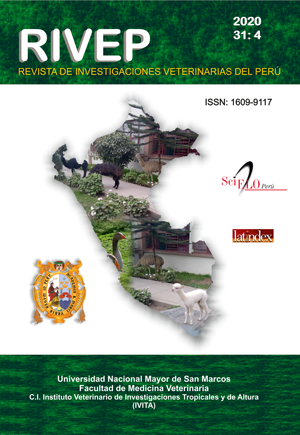Variation factors in the population structure and fibre production in vicuñas of the Cusco Region, Peru
DOI:
https://doi.org/10.15381/rivep.v31i4.19246Keywords:
vicuña, population, production, fibreAbstract
The vicuña is an emblematic species of fauna conservation in Peru. The vicuña population recovered after several years of timely measures for their conservation, moving to appendix II of CITES. Currently there are vicuñas that are kept free (silvestry) and populations kept enclosed in permanent fences (captivity). During 2018, 58 programmed captures (known as Chacus) were done in the Cusco Region, capturing 6777 animals, corresponding to 3229 and 3548 heads for silvestry and captivity, respectively. The age distribution in the case of juveniles was higher in silvestry (18.08%) with respect to the captivity system (7.2%), which would be evidence of the existence of higher mortality in this population. The 2012 national census indicated a higher proportion of female vicuñas in the general population of the Cusco Region; however, in this work similar populations were found by sex in both rearing systems. The proportion of vicuñas sheared with respect to those captured was 52.95 and 30.21% for silvestry and captivity, respectively, while fibre production was 172.4 and 156.7 g per animal on average for silvestry and captivity, respectively. These results lead to the possibility of rethinking the use of permanent fences in the breeding of vicuñas in captivity to produce fibre, considering the lower productive levels obtained in this management system.
Downloads
Downloads
Published
Issue
Section
License
Copyright (c) 2020 Joel Iván Pacheco C., Víctor Manuel Velez M., José Manuel Angulo-Tisoc, Henry Castelo O.

This work is licensed under a Creative Commons Attribution-NonCommercial-ShareAlike 4.0 International License.
AUTHORS RETAIN THEIR RIGHTS:
a. Authors retain their trade mark rights and patent, and also on any process or procedure described in the article.
b. Authors retain their right to share, copy, distribute, perform and publicly communicate their article (eg, to place their article in an institutional repository or publish it in a book), with an acknowledgment of its initial publication in the Revista de Investigaciones Veterinarias del Perú (RIVEP).
c. Authors retain theirs right to make a subsequent publication of their work, to use the article or any part thereof (eg a compilation of his papers, lecture notes, thesis, or a book), always indicating the source of publication (the originator of the work, journal, volume, number and date).



